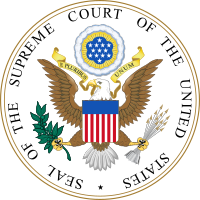Lochner v. New York
Lochner v. New York, (1905), was a landmark decision by the Supreme Court of the United States. The Court ruled a New York State law that set the maximum numbers of hours bakers could work per week was unconstitutional.[1] The Court held that the right of a person to make a contract as a part of his or her business is a liberty protected by the Fourteenth Amendment.[2] With few exceptions this included the right to buy and sell labor.[2] The decision was controversial and it made the Supreme Court an adversary to legislatures for over 30 years.[1] Repeatedly, the Court struck down laws that regulated labor saying they violated the due process clause of the Fourteenth Amendment.[1] This was called the "Lochner Era"; so-named for this decision.[a][3]

Background
changeA statute was enacted by the State of New York which limited the number of hours bakers could work to 10 hours a day or 60 hours a week.[5] The law was a part of the Bakershop Act passed in 1895.[6] The Journeymen Bakers’ Union wanted to limit the number of hours a day union bakers could work.[6] Bakers were then typically paid by the day. The work had a number of health and safety risks due to dust, fumes, the heat of the ovens, etc.[6] The lobbying was successful and in May 1895 the Governor of New York signed the bill into law.[6]
Joseph Lochner, a baker in Utica, New York, found the law made it hard to operate his business.[7] He and his bakers often had to work more than 60 hours a week. Lochner was charged with violating the state law. He filed the appeal because he felt the law was unconstitutional because it violated his Civil liberties of "Life, Liberty and the Pursuit of Happiness".[b][7] The case went before the Supreme Court on February 23rd and was decided on April 17, 1905.[7] The is considered one of the most groundbreaking cases in United States history.[7]
Notes
change- ↑ The Lochner era ended when President Franklin Delano Roosevelt threatened to "pack the court" with new appointees if they didn't stop invalidating his New Deal programs.[3] Following his 1936 reelection, Roosevelt and his attorney general, Homer Cummings, quietly put together a plan to replace many of the aging justices on the Court.[4] But members of the Court realized what was happening and began reversing themselves on earlier labor law cases.[4]
- ↑ This is part of the phrase from the United States Declaration of Independence coined by Thomas Jefferson.[8] The last part was borrowed from John Locke's book An Essay Concerning Human Understanding.[8]
References
change- ↑ 1.0 1.1 1.2 "Lochner v. New York (1905)". PBS/Educational Broadcasting Corporation. Retrieved 29 February 2016.
- ↑ 2.0 2.1 "Lochner v. New York 198 U.S. 45 (1905)". Justia. Retrieved 29 February 2016.
- ↑ 3.0 3.1 "Lochner Era". Legal Information Institute/Cornell University Law School. Retrieved 29 February 2016.
- ↑ 4.0 4.1 William E. Leuchtenburg (May 2005). "When Franklin Roosevelt Clashed with the Supreme Court – and Lost". Smithsonian Magazine. Retrieved 29 February 2016.
- ↑ "Lochner v. New York". IIT Chicago-Kent College of Law. Retrieved 29 February 2016.
- ↑ 6.0 6.1 6.2 6.3 "The New York Bakeshop Act of 1895". Regulation. Archived from the original on 13 March 2016. Retrieved 29 February 2016.
- ↑ 7.0 7.1 7.2 7.3 "Lochner v. New York". Law.com. Retrieved 29 February 2016.
- ↑ 8.0 8.1 "John Locke". Pursuit of Happiness, Inc. Retrieved 29 February 2016.